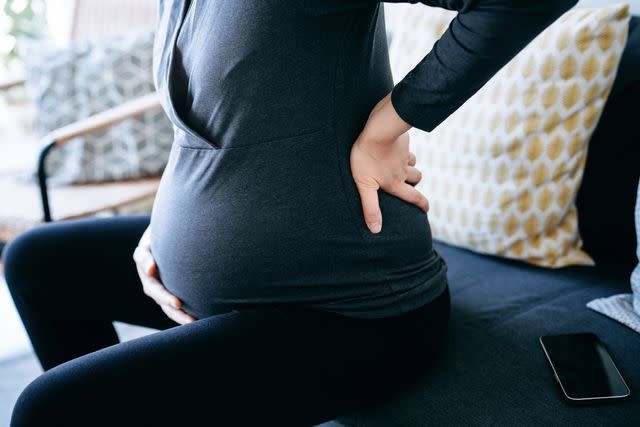Why Some People Have More Braxton-Hicks Contractions Than Others
Medically reviewed by Renita White, MD
Braxton-Hicks are real contractions, but they're not labor contractions. You'll most likely feel them in the third trimester, but they can start well before that. Rest assured, they're a normal part of pregnancy. Some people have a lot more Braxton-Hicks contractions than others. Potential triggers include exercise, dehydration, or having sex.
This article describes Braxton-Hicks contractions, why you might have so many, and when to call a healthcare provider.

d3sign / Getty Images
How Soon Can Braxton-Hicks Contractions Begin?
You might not always be aware of them, but low-intensity, irregular Braxton-Hicks contractions can happen at any time during pregnancy. But don't be surprised if you never feel them because that's also normal.
How Braxton-Hicks Contrations Feel
A contraction is when the muscles of your uterus get tight and then relax again. Braxton-Hicks contractions might feel like this:
There's a squeezing or hardening sensation in the front of your abdomen (pain from labor contractions usually starts in the back and moves to the front)
It may feel like mild to strong menstrual cramping
Your belly might appear a bit pointy, as if your baby is pushing outward
You might have trouble bending or moving
The sensation lasts about 30 seconds to 2 minutes
At first, you might be unable to tell the difference between Braxton-Hicks contractions and labor contractions. But unlike labor contractions, Braxton-Hicks are irregular in length and interval. You might have a strong one followed by a weak one. And though they can be painful, they don't get progressively stronger and closer together like labor contractions.
Timeline of Braxton-Hicks Contractions
When do Braxton-Hicks start? The answer is different for every pregnancy. Braxton-Hicks can start very early in pregnancy, though most people don't feel them until the second or third trimester.
As a general week-by-week pregnancy guide, if you haven't felt Braxton-Hicks at 22 weeks, you may very soon. While some people start to feel them in the second trimester, it's more common in the third trimester.
By week 39, Braxton-Hicks may be more painful and happen more often. But they still don't become regular like true labor contractions.
Causes and Risk Factors of More Braxton-Hicks Than Usual
The exact cause is unclear. The theory is that they are practice contractions that may help strengthen uterine muscles. They may also help the cervix get softer and thinner in preparation for labor and delivery.
The frequency of Braxton-Hicks contractions varies from person to person and from one pregnancy to another. Although your body is getting ready for labor and delivery, having frequent Braxton-Hicks doesn't always mean you're close to labor.
Braxton-Hicks Triggers
If you're wondering why you're having so many Braxton-Hicks contractions, some possible triggers are:
Moving after having been still for a long time
Exercise or general physical activity
Having a full bladder or emptying of the bladder
Movements of the fetus
Having sex
Dehydration
Braxton-Hicks contractions may be more noticeable at the end of the day.
What Helps Ease Braxton-Hicks Contractions?
If they're bothering you, just changing things up a bit can make Braxton-Hicks contractions ease up or taper off. Here are a few things you can try:
Drink water in case you're a little dehydrated.
Do something calming, like meditation, reading, or a warm bath.
If you've been very active, lie down and take a rest.
If you haven't been very active lately, start moving around or take a walk.
If you're in bed, try changing your position.
It's worth noting that none of these things will stop your contractions if you're in true labor. They'll get increasingly stronger and closer together.
When to Check With a Provider
It's a good idea to check with a healthcare provider if you're not sure you're having Braxton-Hicks contractions, especially if you have a high-risk pregnancy. Also, check with a healthcare provider if you thought it was Braxton-Hicks, but contractions are getting more intense and coming at regular intervals.
Signs that you should contact a healthcare provider immediately include:
You have blood or other fluids leaking from the vagina.
Contractions are strong and come every 5 minutes for an hour.
You're in severe pain or have no break between contractions.
There's a change in fetal movement, or you aren't feeling any movement.
Abdominal pain during pregnancy can indicate a urinary tract infection (UTI) or medical emergency such as:
Ectopic pregnancy (the fetus is growing somewhere outside the uterus)
Placental abruption (the placenta is separating from the uterus)
Preeclampsia (high blood pressure and high protein levels in the urine)
Summary
They're real contractions, but Braxton-Hicks are not labor contractions. As with labor contractions, the abdomen tightens and relaxes, but these are irregular. They don't get more intense and closer together. While they may be preparing your body for delivery, they don't signify active labor.
Braxton-Hicks can start at any point during pregnancy. But you're more likely to notice them in the third trimester. They can happen simply because you're a little dehydrated or physically active. Unlike labor contractions, Braxton-Hicks may ease up when you change position or rehydrate.
Call a healthcare provider if you're not sure you're in labor or feel something isn't right. It's best to err on the side of caution.
Read the original article on Verywell Health.

